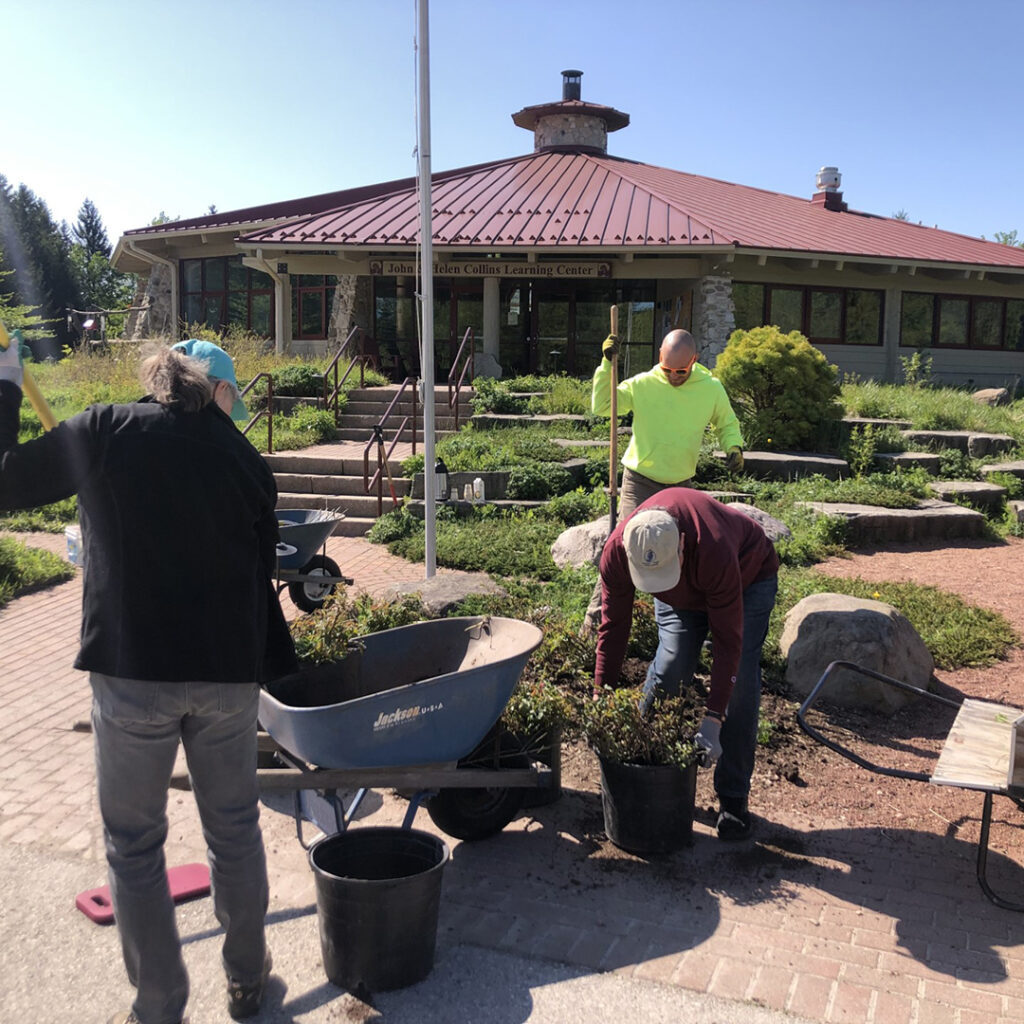By Coggin Heeringa, Interpretive Naturalist, Crossroads at Big Creek, Inc.
Planting Day at Crossroads is coming up on Thursday, September 21! This seems like a rather odd announcement since, during the past three growing seasons, we have planted about 4,000 trees and shrubs annually as a part of our Restoration Project, and we are planting something almost every day this time of year.
But, on Thursday morning, September 21, our Pollinator Pals will be planting native flowers in the Bird and Butterfly Garden at the entrance of the Collins Learning Center. These volunteers will receive help from Master Gardeners and the Wild Ones of the Door Peninsula and anyone else who wishes to volunteer.
We are occasionally asked, “Is it the Pollinator Garden or the Bird and Butterfly Garden?” It’s both – if and only if we plant eco-regional native plants!
Understand that most butterflies and moths lay eggs on one (or just a few) species of native plants. Without those specific species (referred to as host plants), there simply will be no caterpillars. That would be serious because almost all songbirds (approximately 90%) feed their nestlings caterpillars, a perfect soft, protein-rich, vitamin- and mineral-filled baby bird food. Hence the name Bird and Butterfly Garden.
But the Bird and Butterfly Garden has another essential function. It is a Pollinator Garden which meets the needs of countless beneficial insects.
Most people know that European honeybees gather nectar from flowers to make honey to sustain their hives over the winter. (If people don’t know this, they should attend the meeting of the Door County Beekeepers on Tuesday, September 19, at 6:30 p.m. at which Mark Lentz will talk about “Wintering Bees.”) Honeybees aren’t too picky. They will collect nectar from almost any flower they can land on. They are, however, selective about pollen which they need to feed their developing young, and the pollen having high protein and the right amino acids comes predominantly from blooming trees and shrubs in the spring and from yellow and purple flowers this time of year.
Most wild native bee species (and we have hundreds of them in Wisconsin) are hyper-selective about the pollen they collect to feed their offspring. In short, if we don’t plant the right species of flower, we will not have the native bee species that depends on it. But it goes both ways. Without a specific bee pollinating it, the flower species dies out. This is why diversity in a pollinator garden is so important.
Originally, the Collins Learning Center was surrounded by turf grass. It soon became obvious that with each extreme rain event, water gushing off the roof of the building was cutting deep gullies in the lawn. Ironically, the grass also dried out quickly every summer and required almost constant watering, with most of that water ending up on the parking lot.
About that same time, we realized that we lacked an outdoor area where school groups and visitors could gather for orientations, outdoor programs, and events. To solve this problem, Crossroads engaged Meissner Landscaping to design and install a rock garden amphitheater which was planted with typical landscape species, many of which were non-native. This installation was popular and attractive, but it made the entrance asymmetrical. So again, Meissner Landscape was engaged, this time to install rocks and plants on the opposite side of the stairway. During this iteration, they were asked to plant native species. Alas, back then, anything which grew in the Midwest was considered native, so a number of prairie plants were added to the garden. (Prairies are not native to Door County.)
Also during those years, Crossroads volunteers and school groups seeded the area east of the original parking lot with prairie wildflowers. When it became known that an enlarged parking lot would expand into their “wildflower prairie,” members of the Friends group organized work parties to rescue and replant the prairie plants around the learning center.
Again, these prairie plants thrived, some aggressively taking over whole areas and growing to unattractive heights or flopping onto the sidewalk. But here is the kicker: prairie plants often do not meet the needs of many of the native bees in the Great Lakes Region.
Now, thanks to gifts from the Raibrook Foundation, Wild Ones of the Door Peninsula, and several anonymous donors, Jason Miller of Silver Creek Ecological Services was engaged to create a new garden management plan. He supervised volunteers in the removal of the most aggressive of the undesirable plants throughout the summer and ordered eco-appropriate plants which have arrived! Thursday, weather-permitting, the garden planting makeover will occur.
Those who want to help with environmental restorations are welcome to participate as a Pollinator Pal each Thursday morning or to become a Habitat Healer—a volunteer that helps with plantings and invasive species removal on Saturday mornings. (Note: cookies and lemonade are part of the tradition.)
Crossroads at Big Creek Learning Center and Nature Preserve is located at 2041 Michigan Street, Sturgeon Bay. Crossroads is a 501(c)3 organization committed to offering education, conducting research and land restoration, and providing outdoor experiences to inspire environmental stewardship in learners of all ages and from all backgrounds. We welcome your support.



 ALL CONTENT © 2024 BY DOOR GUIDE PUBLISHING
ALL CONTENT © 2024 BY DOOR GUIDE PUBLISHING




